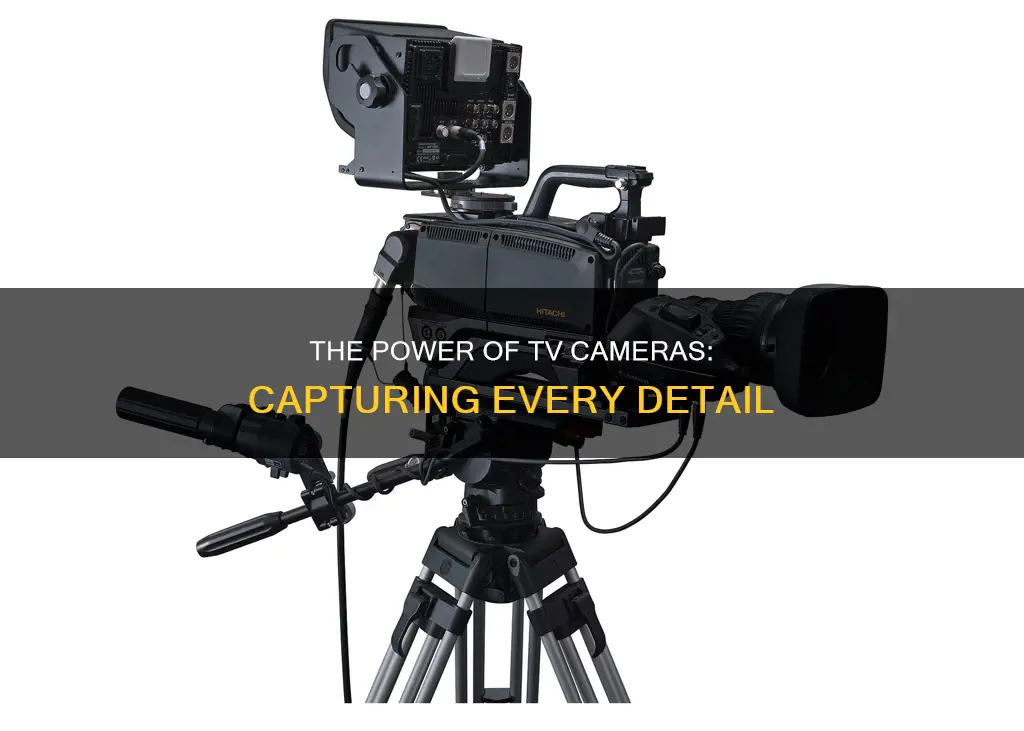
TV cameras are powerful tools that play a pivotal role in broadcasting, delivering live events with impeccable precision. Their large size and high cost are often puzzling, given the existence of smaller, more affordable cameras that can produce better video quality. However, the power of TV cameras lies in their exceptional lenses, advanced electronics, and stability. These lenses, costing up to $200,000, offer unparalleled focal ranges and seamless zooming capabilities, ensuring crystal-clear visuals from significant distances. The camera body, though small in comparison, houses sophisticated sensors and circuitry, processing data at incredible speeds to capture even the fastest of actions.
| Characteristics | Values |
|---|---|
| Lens | Covers a massive focal range, has a wide maximum aperture, is parfocal, is stable, and uses powerful-but-accurate motors for aperture, zoom, and focus control |
| Focal Length | 8.6-900mm (1800mm with a built-in extender) |
| Aperture | f/1.7 – f/4.5 (f/8 at 1800mm) |
| Tripod and Fluid Head | $20,000 |
| Remote Control Handles | $9,000 |
| Camera-to-Lens Adapter | $7,000 |
| Fiber Optic Transmission Module | $3,000 |
| Camera Body | A high-tech hive that houses advanced imaging sensors and circuitry that processes data at breakneck speeds |
What You'll Learn

TV camera lenses are extremely expensive
The cost of a broadcast setup can be as high as $250,000, and the lens alone can account for 90% of that cost. For example, a Fujinon UA107 lens can cost $212,000, while the camera itself may only be $3,000. So, why are TV camera lenses so expensive?
Firstly, TV camera lenses are designed to make absolutely no compromises. A broadcast lens costing over $200,000 is an all-in-one lens, covering a massive focal range with a wide maximum aperture. It is parfocal, meaning there is no need to refocus as you zoom in and out, which is vital for live broadcasts. It also offers image stabilisation, razor-sharp focus across its entire focal length, and powerful-but-accurate motors for controlling aperture, zoom, and focus.
Secondly, TV camera lenses need to be able to adapt to almost any environment, from talk shows to sports coverage. This versatility comes at a high cost, and the equipment needs to be durable and reliable to withstand different conditions.
Finally, the manufacturing process for these high-end lenses is intricate and time-consuming. Each lens element must be carefully crafted and polished to meet the demanding standards of broadcast television. The complex design and advanced features of these lenses contribute to their high price tags.
In summary, TV camera lenses are extremely expensive due to their uncompromising performance, versatility, and the complex manufacturing processes involved. These lenses are built to meet the demanding requirements of broadcast television, offering exceptional image quality, durability, and adaptability for various shooting environments.
Smart TV Camera: A Hacker's Window to Your Home
You may want to see also

Lenses are heavy and large
Lenses on TV cameras are large and heavy because they are powerful. The focal length of a lens is the distance between the rear nodal point and the focal point. The longer the focal length, the bigger the lens needs to be.
TV camera lenses are also compound lenses, which are made from a combination of individual lenses called lens elements. The more lens elements, the heavier the lens.
The aperture of a lens is a function of focal length. Aperture refers to the opening of the lens iris. The longer the focal length, the wider the aperture needs to be.
TV camera lenses also tend to have large maximum apertures. This means that the lens iris opening is large, which in turn means that the lens itself needs to be large.
The flange focal distance is the distance between the lens mount and the sensor. The further away from the flange focal distance, the bigger the lens will be.
TV camera lenses also tend to have a long focal range, which means that they can zoom in and out a lot. This requires a lot of powerful but accurate motors for aperture, zoom, and focus control. These motors add weight to the lens.
In summary, TV camera lenses are large and heavy because they have a long focal length, a lot of lens elements, a wide aperture, a long focal range, and powerful motors. These features work together to create a powerful lens that can capture high-quality images and video, but they also make the lens heavy and large.
Creepy Boss, Watching Cameras: What to Do?
You may want to see also

Cameras need to adapt to the environment
The size and cost of TV cameras are often attributed to the massive lenses used in broadcast setups. However, it's important to understand that the camera itself also plays a crucial role in adapting to various environments.
In traditional video production, the environment is typically adapted to suit the camera's needs. Lighting, sets, and other factors are carefully controlled to ensure optimal conditions for filming. This allows for the use of smaller and more compact camera equipment.
However, in broadcast television, the camera must be able to adapt to a wide range of environments, from well-lit studios to outdoor locations with varying lighting and weather conditions. This versatility comes at a cost, both in terms of the size and expense of the equipment.
Broadcast cameras need to have a wide range of features and capabilities to handle different scenarios. They require large lenses with a massive focal range, wide maximum aperture, parfocal capabilities, and powerful motors for precise control over aperture, zoom, and focus. These lenses are designed to capture clear and sharp images, whether the subject is nearby or at a distance.
Additionally, broadcast cameras often have advanced stabilisation features, such as robust tripods with fluid heads, to ensure smooth and steady shots even in challenging conditions. The camera body itself is also designed to handle a variety of situations, with efficient heat dissipation systems to prevent overheating during long shoots.
The electronics and processors within the camera play a crucial role as well. They enable precise control over various functions, responding to the director's remote commands with utmost accuracy. Light sensors work tirelessly to adjust exposure levels, ensuring consistent image quality regardless of the lighting conditions.
In summary, the power of TV cameras lies not only in their ability to capture high-quality images but also in their adaptability to diverse environments. This versatility comes at a cost, resulting in larger and more expensive equipment. By investing in robust and adaptable camera systems, broadcasters ensure that they can deliver a seamless viewing experience to their audience, regardless of the challenges posed by the filming location.
School Bus Camera Footage: Who's Watching?
You may want to see also

Electronics are the brain behind the camera
Electronics are the brain behind the brawn of broadcast cameras. They are the unsung heroes, the maestros conducting the symphony of zoom and focus. Within the muscular frame of a broadcast lens lies intricate optics, and it is the electronics that curate seamless transitions. Processors calculate and control every motorized nuance, responding to a director's remote commands with the precision of a Swiss watch. Light sensors tirelessly tweak exposure, ensuring consistent brilliance.
The electronics are the reason these cameras can adapt to almost any environment. They enable the camera to capture razor-sharp images from a whisper away to the horizon without missing a beat. They are the reason these cameras can zoom in and out in real-time, essential for live TV where there are no second takes.
The electronics are also responsible for the smooth and unshakeable support of the camera. They work in tandem with the Herculean tripods, which provide a steadfast base for the camera to capture clear shots even in challenging conditions. The electronics and tripods work together to ensure the camera's stability, allowing for buttery smooth motion.
The electronics are an integral part of the camera's heat dissipation system. They ensure that the camera can efficiently dissipate heat, preventing overheating and ensuring the show goes on without interruption.
In summary, the electronics are the brain behind the camera, controlling and fine-tuning its various functions to deliver impeccable precision in live broadcasting. They enable the camera to adapt to different environments, capture clear shots, and operate without interruption, making them a crucial component of the powerful TV cameras used today.
Can My TV Spy on Me?
You may want to see also

Stability is key for TV cameras
The stability of a TV camera setup starts with the tripod. These tripods are designed to provide a steadfast base, ensuring the camera remains steady even in difficult weather conditions. They are equipped with fluid heads, which enable smooth and jerk-free movements, contributing to the overall stability of the camera during operation.
In addition to the tripod, the camera's lens plays a crucial role in maintaining stability. The lens needs to be parfocal, which means it can stay in sharp focus during zooming. This feature ensures that the camera captures clear and stable footage, regardless of the distance from the subject.
The camera body itself also contributes to stability. It houses advanced imaging sensors and circuitry that can process data at incredibly fast speeds, ensuring that fast-paced action can be captured without blur or distortion. Additionally, the camera body efficiently dissipates heat, preventing overheating that could disrupt the stability of the camera's performance.
The stability of a TV camera setup is a result of the harmonious interplay between the tripod, lens, and camera body. Each component works together to provide a solid foundation, ensuring that the camera captures clear and stable footage, even in the demanding world of live broadcasting.
Android Smartwatches: Camera-Equipped or Not?
You may want to see also
Frequently asked questions
TV cameras are powerful because they have to adapt to almost any environment and shooting condition. They are designed to capture clear shots with a wide range of zoom and focus capabilities, often from great distances.
The key components that make TV cameras so powerful are their advanced lenses, camera bodies, electronics, and stabilisation systems.
TV cameras offer more flexibility and features that are essential for live TV broadcasting. They provide exceptional optical quality, stability, and smooth motion, ensuring that every shot is captured with precision and clarity.







